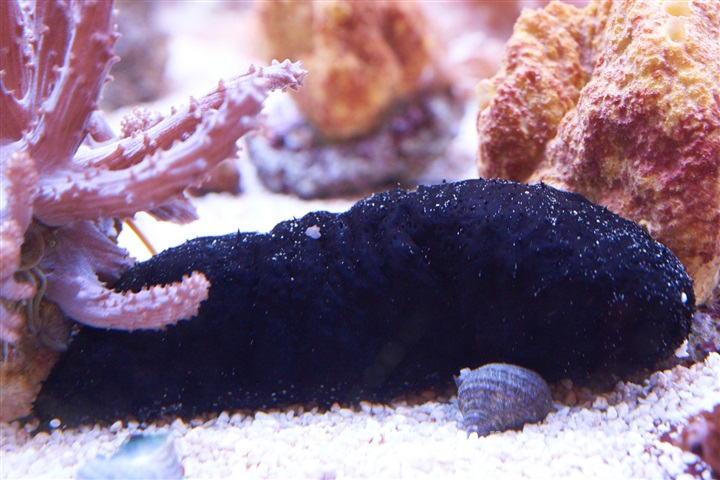Holothuria sp.

| Latin name | Holothuria sp. |
|---|---|
| Local name | Sea Cucumber |
| Family | Holothuriidae - Holothuria |
| Origin | East Indian Ocean, Indonesia |
| Max length | 30 cm (11.8") |
| Minimum volume |
200 l (53 gal) |
|---|---|
| Hardiness |
Hardy |
| Suitable for aquarium |
Suitable for most aquarium |
| Reef safe |
Always reef safe |
| Aggressiveness | Peaceful |
| Recommended |
Detritus Microalgea (Eg. spirulina) |
|---|
This species can release poison into the water when stressed or dies.
It can be fatal to fish and invertebrates.
This rarely happens if the appropriate precautions are taken.
This species is very sensitive during transportation and acclimatizing into the aquarium.
A large area with fine grained sand should be available if housing a sea cucumber. The substrate should be at least 1" (2 cm) thick, other wise the sea cucumber may starve.
The sand must have time to get established before adding the sea cucumber, otherwise it may not be able to sustain enough food for the sea cucumber.
This genus of sea cucumbers filters the substrate for food.
These sea cucumbers should only be kept in tanks with a large area of sandy substrate.
They leave behind "spaghetti" like sand, which is a good sign that enough food is available.
It is important that the sand is fine grained (less than 2 mm). Only large specimens will be able to filter 2 mm sand.
A rule-of-thumb says that you can stock 3" (7 cm) of sea cucumber per 20 gal (100 liter).
If the sand is not rich on food for the sea cucumber, then even more space is required.
Sea cucumbers vary a lot in size and the way they feed.
Some species are good at keeping the sand clean while others are filter feeders.
The size can very from 1" (2 cm) to 3' (1 meter).
All sea cucumbers will shrink if they are not provided with enough food.
If a sea cucumber dies or gets extremely stressed it might release toxic chemicals, which might poison fish and invertebrates.
This is rare, but you should ensure that it doesn't get stuck in pumpes or the overflow.
Sea apples pose a greater risk of poisoning the tank than the other sea cucumber species.
Rob Toonen. 2003. Aquarium Invertebrates: Sea Cucumbers - Part II - Advanced Aquarist - (English)
Scott W. Michael. Sea Cucumbers - Fish Channel - (English)
Bob Fenner. Sea Cucumbers: Not A Pretty Picture - Wet Web Media - (English)

